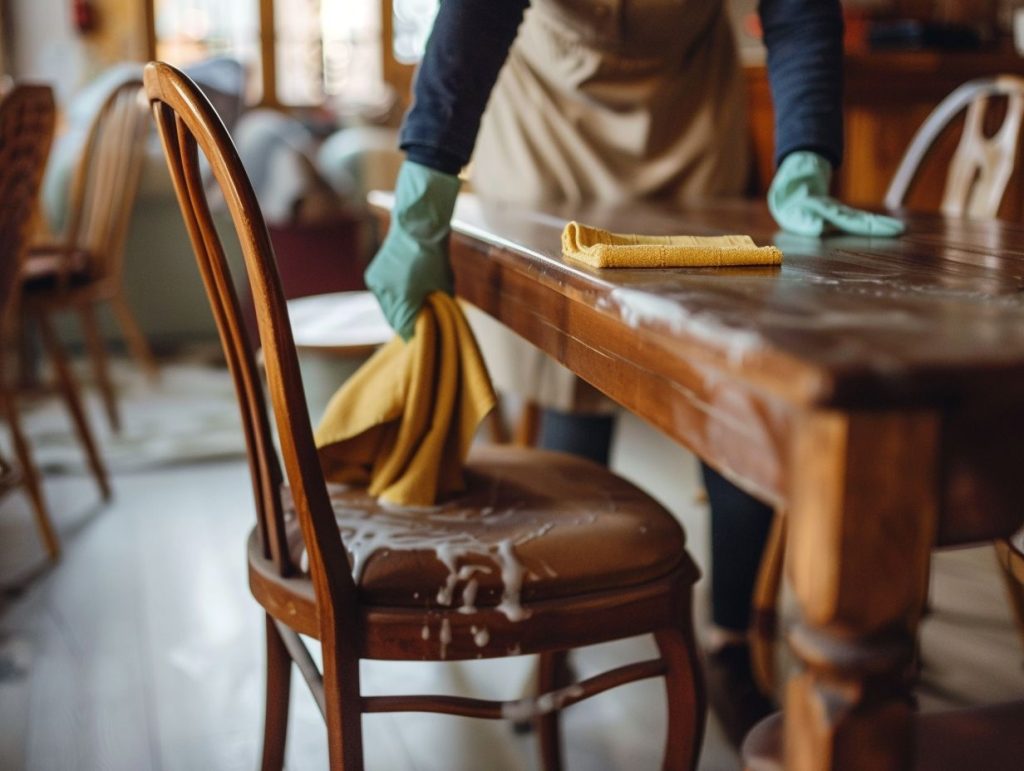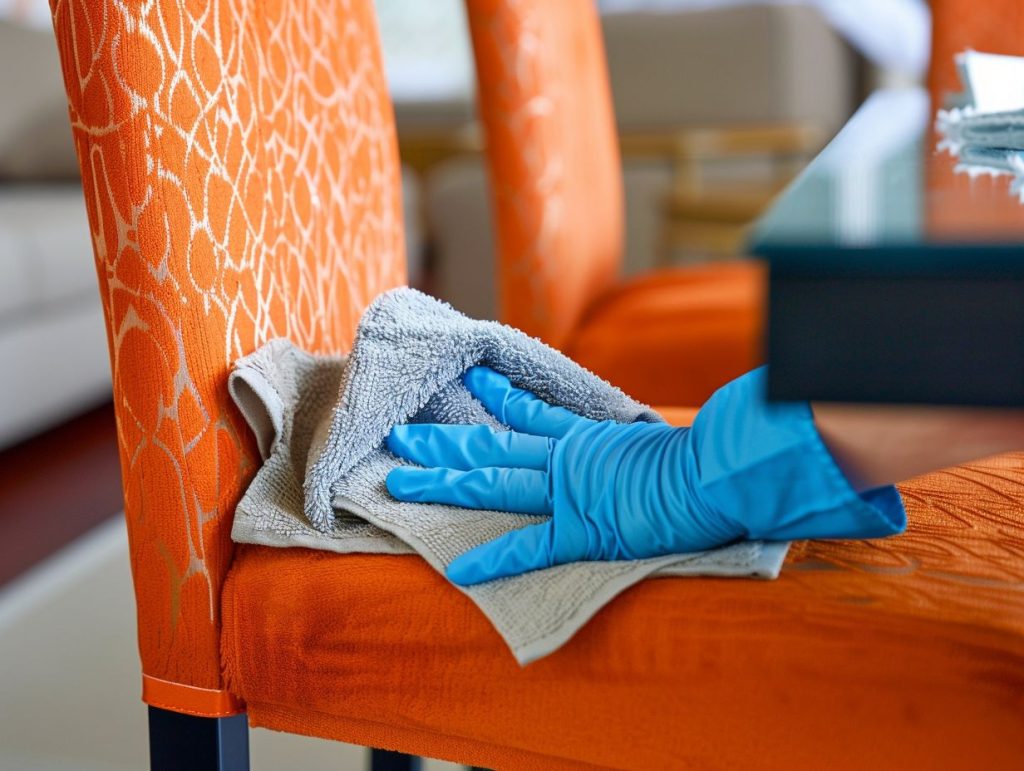If your upholstered dining chairs look worse for wear, it’s time to give them a good cleaning. You need to stay on top of regular maintenance to keep them looking fresh and ready for those dinner guests.
In this guide, we’ll walk you through cleaning your upholstered dining chairs. We’ll cover the materials and tools you’ll need, essential supplies for cleaning, preparation steps, different techniques for tackling stains, tips for keeping things clean, and tricks for dealing with those pesky stubborn stains.
Keep reading to discover how to make your dining chairs look brand new again!

Why Regular Cleaning is Important
Regularly cleaning your upholstered dining chairs is vital to keeping them looking good, lasting longer, and keeping your home environment healthy.
When you make cleaning your dining chairs a habit, you’re not just maintaining their appearance but also preventing them from wearing out quickly. This routine helps preserve the chairs’ beauty and structure, shielding the fabric from stains and spills so they can stay in great shape for a long time.
Well-kept upholstered chairs spruce up your home decor and create a neat and welcoming atmosphere for you and your visitors. Adding fabric protection methods adds an extra layer of defence for your furniture, ensuring it stays fresh and new-looking for extended periods.
Materials and Tools Needed
When cleaning your upholstered dining chairs, you’ll need a mix of materials and tools, such as specialised cleaning products, a reliable vacuum cleaner, and perhaps even a steam cleaner for more thorough cleaning tasks.
Essential Supplies for Cleaning
To clean your upholstered dining chairs, you’ll need some essential supplies. Grab soft brushes, microfibre cloths, a vacuum cleaner with upholstery attachments, and gentle cleaning products that match your fabric type.
To get those chairs looking spick and span, kick things off by using a soft brush to brush away any loose dirt or debris gently. Then, take a microfibre cloth dampened with a gentle cleaning product and carefully dab at any stains on the fabric. Double-check the label on the cleaning product to ensure it’s safe for your chair’s fabric. Don’t forget to use the upholstery attachment on your vacuum to get into those nooks and crannies, sucking up dirt, dust, and allergens that have made a cosy home in the fabric.

Step-by-Step Guide for Cleaning
Follow this step-by-step guide to ensure your upholstered dining chairs stay spotless and in top-notch condition. It covers everything from regular care to deep and handy spot-cleaning techniques.
Preparation and Pre-Cleaning Steps
Before you start cleaning, prepare your upholstered dining chairs. Begin by performing pre-cleaning steps like hoovering to remove loose dirt and debris. Also, remember to pre-treat any visible stains using spot-cleaning methods.
This preparation is critical because it lays the groundwork for a successful cleaning session. Hoovering does more than remove surface dirt; it stops it from getting pushed further into the fabric during cleaning. Identifying and pre-treating stains in advance increases the chances of getting rid of them effectively. And applying fabric protection after cleaning can shield your upholstery from potential damage, making it last longer.
Investing a little time in these prep tasks will help you keep your upholstered dining chairs clean and sturdy for the long haul.
Cleaning Techniques for Different Types of Stains
When dealing with different stains on your upholstered dining chairs, you must use specific cleaning techniques and solutions to remove them without ruining the fabric.
If you have food stains, such as spaghetti sauce or wine spills, gently blot the area with mild dish soap and water. You should use surgical spirit or a specialised ink remover for ink stains. For grease stains, sprinkle some bicarbonate of soda or cornflour on the spot and vacuum it up.
Remember, the key is to act swiftly and carefully when handling stains to prevent them from becoming permanent fabric residents.
Tips for Maintaining Clean Upholstered Dining Chairs
Set up a regular cleaning routine and follow good upholstery maintenance habits to keep your upholstered dining chairs looking fresh and lovely.
Preventative Measures and Regular Maintenance
To keep your upholstered dining chairs looking fresh and fabulous, you’ve got to take some proactive steps and stay on top of regular maintenance. This way, they’ll continue to be a stylish and practical addition to your home decor.
One handy trick is to use fabric protection sprays. These chaps create a shield against spills and stains, so you can quickly clean up any messes that sneak onto your chairs.
When you’re seated at the dining table, try to avoid messy foods and colourful drinks. This simple habit can prevent unsightly stains from ruining your chairs.
Remember regular upkeep! Give your upholstered chairs a good hoovering once a week to remove dirt and debris that could cause wear and tear over time.
And if a spill does happen, don’t waste any time. Grab a gentle cleaning solution and tackle that stain pronto. Taking care of spills immediately makes a difference in preserving the beauty and longevity of your upholstery.
Dealing with Stubborn Stains
When stubborn stains appear on your upholstered dining chairs, it can be quite a nuisance. But fear not! Proper cleaning methods and products allow you to deal with and remove even the most stubborn marks easily.
Advanced Techniques and Products for Tough Stains
You must bring out the heavy artillery when facing tough stains that won’t shift. Consider advanced cleaning techniques and specialised products, like steam cleaning and top-notch stain removers—your best bet for getting the job done.
Dealing with stubborn stains like grease, ink, or wine requires a targeted approach for the best results. Take steam cleaning, for example – it’s like magic for those deep-seated stains, getting right into the fibres and lifting them out easily. And don’t forget those professional-grade cleaning products made specifically for certain stains – they’ll outperform any generic solutions. Always read and follow the manufacturer’s instructions carefully to apply these products like a pro. And hey, it’s always a good idea to test them on a small, hidden spot first to ensure they work well with the fabric or surface.
